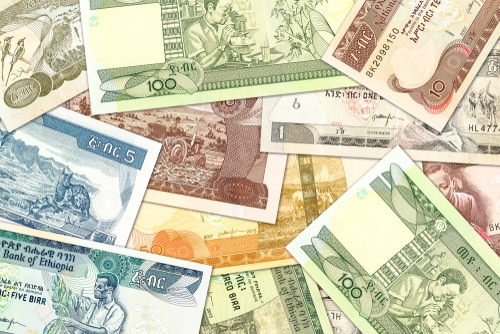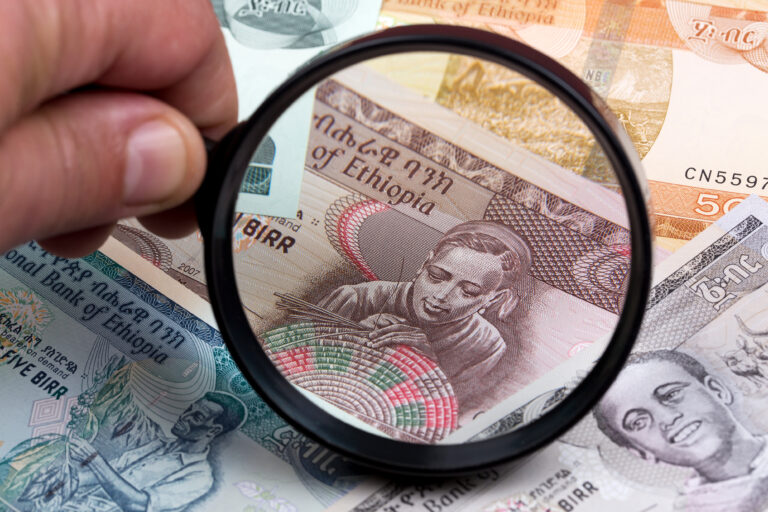Whether you want to send money home or plan a trip to Ethiopia, it is important to know about the country’s money—the Ethiopian Birr (ETB). This way, you can feel more sure about what to do and be ready for your visit. In this guide, we talk about where the birr comes from, how people use it now, and a few interesting facts. These facts show what the birr means to the people and how it is part of the country’s money system.
What Is the Ethiopian Birr?
The Ethiopian Birr is the official money used in Ethiopia. It has the ISO code ETB. In day-to-day life, you will find it written as:
- ETB is used for international banking and as a currency code.
- Br is a Latin abbreviation.
- ብር is written in Amharic.
Each birr has 100 santim. The National Bank of Ethiopia gives out and controls the money.
Banknotes and Coins in Circulation
- Banknotes: These come in the amounts of 1, 5, 10, 50, 100, and 200 birrs.
- Coins: There are coins worth 1 birr. You can also find coins of 1, 5, 10, 25, and 50 santim.

5 Fascinating Facts About the Ethiopian Birr
1. Ethiopia Used Salt and Foreign Coins Before the Birr
Long before the birr came, people in Ethiopia would use blocks of salt called amole tchew for trading. They also used Maria Theresa thalers, which are old silver coins from Austria. The way people used these things shows that Ethiopia had an important part in trade in the area before new kinds of money started to be used.
2. Lions Symbolize National Identity on Coins
The 1-birr coin shows a lion’s head. This stands for the Lion of Judah, which is a sign tied to Ethiopian royalty and the Bible. The coin uses two types of metal. There is a nickel-brass center and a nickel-plated steel ring. This mix makes the coin strong and gives it a special look. The design also shows how important the lion is to the country.
3. New High-Value Banknotes Launched in 2020
To deal with rising prices and make the currency system better, Ethiopia brought out new designs for the 10, 50, and 100 birr notes in 2020. A new 200-birr note was also added. The older 10, 50, and 100 birr notes were stopped by the end of that year.
4. Ethiopian Currency Is Printed Abroad
Ethiopia’s banknotes are printed by De La Rue, which is a big company in the UK. This company makes money for many different countries. A lot of African countries, including Ethiopia, do not have their own places for high-security money printing. Because of that, it is important for them to work with companies from other countries.
5. The Birr Is Considered an “Exotic Currency”
In global markets, the ETB is called “exotic”. This word means that people do not trade it as much as big currencies like the USD or EUR. This can make it change in value more, and it can be tough to get it if you are not in Ethiopia. Because of this, it can affect the rates for sending money or changing money when you travel.
About Ethiopia
Ethiopia is in the Horn of Africa. There are over 100 million people who live there. It is one of the world’s oldest cultures that is still around today. The capital city, Addis Ababa, is important for both politics and culture in Africa.
Ethiopia boasts:
- The country has many types of land, such as mountains, deserts, and the Great Rift Valley.
- There are many ethnic groups in the country. Some of the main ones are Oromo, Amhara, Somali, and Tigray.
- People follow many religions here. There are strong groups for Orthodox Christian, Muslim, and Protestant faiths.
- Amharic is the national language, but people also speak many other local dialects.
Ethiopian food is known for injera and spiced stews. People all over the world know about this. This food comes from old traditions and is very important in their culture.
Frequently Asked Questions About the Ethiopian Birr (ETB)
What does ETB stand for?
ETB is the ISO currency code for the Ethiopian Birr. You might also see it represented as Br in Latin script or ብር in Amharic.
How many santim are in one birr?
One birr is equal to 100 santim, similar to how 100 cents make up one dollar.
Can I use US dollars or euros in Ethiopia?
While some hotels and tour operators may accept major foreign currencies, it’s best to convert your money into birr for everyday purchases and transportation within Ethiopia.
What denominations of birr are in use today?
- Banknotes: 1, 5, 10, 50, 100, and 200 birrs
- Coins: 1 birr, 50, 25, 10, 5, and 1 santim
Note: As of 2020, older versions of 10, 50, and 100 birr notes were demonetized.
Where is Ethiopian currency printed?
The Ethiopian Birr is printed by De La Rue, a British company that specializes in secure currency production.
Why is the birr called an “exotic currency”?
In foreign exchange markets, “exotic” means a currency is not widely traded internationally and may be harder to exchange outside its home country. The birr fits this category, making it important to plan ahead when traveling or sending money.
Is the exchange rate for ETB stable?
The ETB is subject to market-driven fluctuations. Ethiopia’s transition to new notes in 2020 aimed to reduce inflation and stabilize the currency, but rates can still vary, so it’s smart to check current rates before sending money or exchanging currency.

